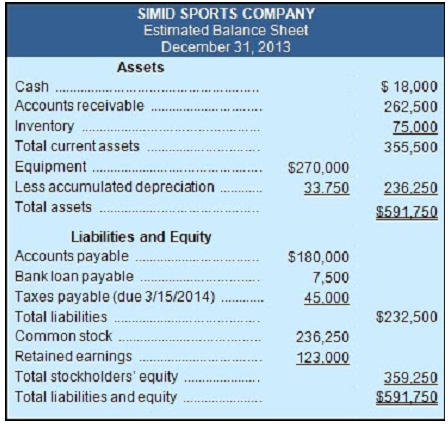Case Study
Near the end of 2013, the management of Simid Sports Co., a manufacturing company, prepared the following estimated balance sheet for December 31, 2013.

To prepare a master budget for January, February, and March of 2014, management has gathered the following information:
• Simid Sports' single product is purchased for $30 per unit and resold for $55 per unit. The expected inventory level of 2,500 units on December 31, 2013, is more than management's desired level for 2014 which is 20% of the next month's expected sales (in units). Expected sales are:
o January, 3,500 units;
o February, 4,500 units;
o March, 5,500 units; and
o April, 5,000 units.
• Cash sales and credit sales represent 25% and 75%, respectively, of total sales. Of the credit sales, 60% is collected in the first month after the month of sale and 40% in the second month after the month of sale. For the December 31, 2013, accounts receivable balance, $62,500 is collected in January and the remaining $200,000 is collected in February.
• Merchandise purchases are paid for as follows: 20% in the first month after the month of purchase and 80% in the second month after purchase. For the December 31, 2013, accounts payable balance, $40,000 is paid in January and the remaining $140,000 is paid in February.
• Sales commissions equal to 20% of sales are paid each month. Sales salaries (excluding commissions) are $30,000 per year.
• General and administrative salaries are $72,000 per year. Maintenance expense equals $1,000 per month and is paid in cash.
• Equipment reported in the December 31, 2013, balance sheet was purchased in January 2013. It is being depreciated over eight years using the straight-line method with no salvage value. The following amounts for new equipment purchases are planned in the coming quarter: January, $18,000; February, $48,000; and March, $14,400. This equipment will be depreciated using the straight-line method over eight years with no salvage value. A full month's depreciation is taken for the month in which equipment is purchased.
• The company plans to acquire land at the end of March at a cost of $75,000, which will be paid for with cash on the last day of the month.
• Simid Sports has a working arrangement with its bank to obtain additional loans as needed. The interest rate is 12% per year, and interest is paid at each month-end based on the beginning balance. Partial or full payments on these loans can be made on the last day of the month. The company has agreed to maintain a minimum ending cash balance of $12,500 each month.
• The income tax rate for the company is 40%. Income taxes on the first quarter's income will not be paid until April 15.